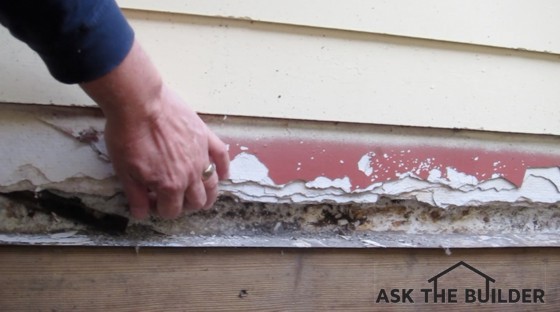What are Flashings?

What are Roof Flashings? | This is an inferior metal flashing that's on top of the wood and extends up behind the siding. It was supposed to be longer and the metal bent over the bare piece of lumber. Photo Credit: Tim Carter
Roof Flashings - They're Easy to Install
Quick Column Summary:
- What are flashings
- Install flashings properly
- Flashings protect your home from water
- How to make your flashings waterproof
- From the September 9, 2014 Newsletter
DEAR TIM: I'm looking at bids right now for a re-roof project and a new deck job at my home. The bid documents mention flashings. I have no clue what they are and whether or not they're important.
If they are important, what should I know to ensure they're installed correctly? I realize it's impossible for you to tell me all you know about this topic, but give me enough to make sure the job's done right. Ally T., Philadelphia, PA
Author's Note: Be sure to watch all the videos below showing different roof flashings and how they should be installed.
DEAR ALLY: I'm glad you understand the space limitation I have. This would not be the first time I could write a book about a small sliver of home construction materials and installation tips. Flashings are critical parts of many aspects of building a home and are not limited to roofs and decks. Windows, doors, brick, skylights, chimneys, etc. all can have flashings attached to them.
Think of a flashing as a roof shingle or a piece of wood siding for just a moment. Imagine a simple roof on a dog house. A rain drop at the top of the roof rolls across shingle after shingle until it gets to the bottom of the roof. It then falls to the ground.
The same is true for wood or vinyl siding on a home. Imagine a wall that has no windows or doors in it. All it has is one lapped piece of siding on top of another. When water starts at the top of the wall, it just runs across each piece of siding until it gets to the last piece and then falls to the ground.
But what happens when things interrupt shingles, siding, brick, stone or any other exterior finish that's meant to keep water from inside your home? At these locations you need a flashing to make sure the water continues on it's journey to the ground and doesn't take a detour to the inside of your house.
A flashing is a waterproof material that diverts or redirects water to a point lower on the outer face of a building. Think of a flashing as a transitional building material. It connects something that's often waterproof to something that's not. I realize this is confusing, so I'll give you some examples.
You'll often discover a metal flashing, surrounding a skylight you might have in your roof. The flashings are often bent metal that lay under and over shingles, go up the sides of the skylight and connect to the top of the skylight in such a way that driving rain can't leak into your home.
You'll discover flashings where a roof butts up against a wall of a house or where a chimney is popping up through a roof or next to a roof. The flashings can be made from galvanized steel, tin-coated steel, lead, copper or even a rubber membrane.
Flashings are mission critical in brick or stone-veneer construction. Water readily leaks through brick and stone veneer and must be captured by flashings you can't see behind the brick or stone. This water is then redirected to the exterior of the building via weep holes.
Great builders install flashings on top of windows and doors. The water streaming down a wall would love to get behind the window or door. The flashing on top prevents this from happening and sends the water streaming across the front of the window or door so it can get to the ground.
Installing flashings is an art and craft. I've seen countless poor installations in my day and I shake my head. When I was a young carpenter and builder, I had the good fortune to work on many an old home built in the early 1900's. I studied the flashings I would see on chimneys, dormers, and old-fashioned box gutters. Many were built and fabricated by true craftsman. I was lucky to be able to copy their skills and magic.
It didn't take long to see how the seams were formed and how the flashings were constructed to guide the water so it continued it's journey to the ground. One thing I noticed right away is that flashings always had a slope built into them so water never ponded on them. Gravity always pulled water down or off the flashing to the building material just below the flashing.
Flashing materials almost always need to be cut and bent. Any seam in a flashing must be made waterproof. When you use galvanized metal, tin-coated steel, copper or lead, you can solder these seams to create a waterproof seal. Rubber membranes come with special solvents that allow you to weld to pieces of rubber together.
Never ever rely on caulk as a permanent sealant for a flashing. It's not uncommon for a flashing to have a life expectancy of 50 or more years. I've never seen a caulk that can last for that long, but solder does.
Beware of using aluminum as a flashing material in contact with masonry. The chemicals in the mortar can corrode the aluminum causing leaks.
If you need PHONE COACHING how to install flashings or LOCATE a ROOF LEAK, you can go here to set up a phone call with me, Tim Carter.
Column 1056
One Response to What are Flashings?